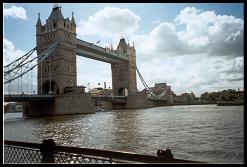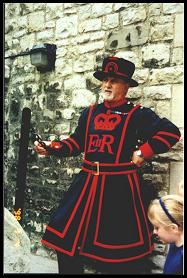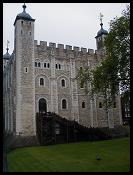
The Tower Bridge
|
The Tower of London was founded nearly
a millenium ago and expanded with a long time. It has protected,
housed, imprisoned and been for many people the last sight
they saw on Earth. It's situated in East London, next to the
famous Tower Bridge. The Bridge was built between 1886 and
1894 by the City of London Corporation to link the southeastern
suburbs with the city and eastern London.
The Tower of London is the oldest palace,
fortress and prison in Europe. The great fortress was created
by William the Conqueror.
The Tower is entered at the foot of
Tower Hill. Near there is the Bulwark Gate. A lot of prisioners
were closed here. Next to this place, there is the Lion Tower
where the royal menagerie took place. At the same area there
are the Traitor's Gate and the St. Thomas's Tower.
|
|
|

A Yeoman Warder.
|
One of the most popular
attraction in the Tower of London are the Yeoman Warders, also
known as Beefeaters. It was originally established in 1485 as
King Henry VIII's guardians. They are usually seen at the Tower
in the blue undress uniform granted to them by Queen Victoria
in 1858.
Opposite Traitor's Gate we find the
Wakefield Tower, built in the early 13th century. Wakefield
Tower was probably named after William the Wakefield. The
tower has 2 chambers, the ground floor and the royal apartments
above. Henry VI died in the Wakefield Tower in May 21th of
1471.
|
|
The White Tower is the great central
keep that was built by William the Conqueror and finished
by his sons and successors, William Rufus and Henry I. This
tower contained the first royal observatory. It has a single
and original entrance. In the White Tower the medieval kings
of England lived with their families and their court.
On the first floor of the White Tower
there is the Chapel of St John the Evangelist. It is one of
the most perfect specimens of Norman architecture in Great
Britain.
The White Tower and the New Armouries
contain the national collection of arms and armour. It's the
most important fortress in the kingdom. The White Tower is
entered through the Tournament Room. The Tudor Room is devoted
mainly to the armours made in the royal workshops at Greenwich
which Henry VIII established in 1514. In the Stuart Room there
are beautiful little armours made in France and England.
|

The White Tower
|
On the west side of the White Tower is the
Tower Green, which is bounded on the north by the Chapel of St Peter
and Vincula, and on the south by the Queens House. On the west green
stands the Beauchamp Tower, created by Henry III and his son.
Between the Chapel and Tower Green is a small
paved area. There is the Site of Block. The names of the six tragic
figures who died on this fateful spot are inscribed on the board.
They include three queens of England: Anne Boleyn, Catherine Howard
and Lady Jane Grey. Elizabeth I, Robert Devereux, Earl of Essex
were also executed here.
On the left there is The Queens House that
was built in 1530, probably for Queen Anne Boleyn, but she lived
there only as a prisoner for 18 days while waiting her execution.
It is a very fine example of half timbered Tudor architecture.
On the right of the Site of Block there are
The Crown Jewels, that are what most visitors of the Tower of London
come to see. This incomparable collection of crowns, orbs, swords,
sceptres and other regalia, and gold and silver plate was refashioned
in 1661 after the parliament had ordered the original gold and precious
metals to be melted down for coinage in 1649.
|
